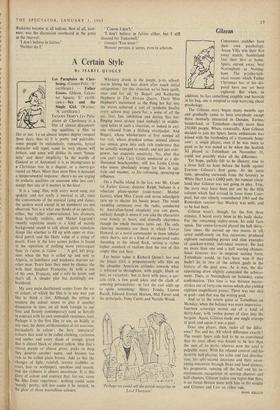A Certain Style
By ISABEL QUIGLY Les Parapluies de Cher- bourg. (Cameo-Poly; 'A' certificate.) — Father Goose. (Odeon, Leices-
ter Square; certifi- cate.)—Sex and the Single Girl. (Warner; 'A' certificate.) JACQUES DEMY'S Les Para- pluies de Cherbourg is a film of almost disconcert- ing qualities, a film to like or not. 1 o an almost suspect degree (suspect these days, that is) it is pretty and palatable; some people its melancholy, romantic, lyrical character will repel, some its very charm will irritate, and some will dislike its overt 'femin- inity' and sheer simplicity. In the worlds of Godard or of Antonioni it is as incongruous as a Christmas tree in a dugout, or a merry-go- round on Mars. More than most films it demands a temperamental response: there's no use urging its aesthetic qualities on someone who just can't accept that any of it matters in the least.
It is a 'sung' film, with every word sung, not spoken; and not really a musical at all, since the conventions of the musical (song and dance, the spoken word except in set numbers) are not.. observed. Nor is it what one thinks of as operatic, either, but rather conversational, less dramatic than lyrically realistic, and Michel Legrand's sweetly repetitive music is a kind of moody background sound to talk about quite mundane things like whether to fill up with super or stan- dard petrol, and the likely value of a string of pearls. Even in the love scenes pathos is found in the repetition of nothing more extravagant than 'Je rainie, je raime . . .' A girl, left preg- nant when the boy is called up and sent to Algeria, in loneliness and weakness marries an- other man. Years later they meet by chance, she with their daughter Francoise, he with a son of his own, Francois, and a wife he loves; and that's all. A slender plot but dazzlingly em- broidered.
My own main dazzlement comes from the use of colour, of which the film is in any way you like to think a riot. Although the setting is modern the colour seems to give it another dimension in time, an air both foreign to our time and fiercely contemporary (and so fiercely In contrast with its own unmodish sweetness, too). Perhaps it is the first film to use, so boldly at any rate, the dense artificiousness of art nouveau, Particularly in colour: the fiery 'unnatural' colours that used to be called clashing, cyclamen and umber and every shade of orange, green that is almost black or almost yellow, blue that's almost purple or almost green, pinks so deep they deserve another name, and browns too rich to be called plain brown. Add to this the changes of light, rainfall, texture (cobbles or
coats, hair or wallpaper), sunshine and season, and the richness is almost inordinate. It is this glory of colour and contrast that, for me, saves the film from sugariness: nothing could seem merely' pretty, still less could it be insipid, in the glow of those marvellous colours.
Whiskery drunk in the jungle, p. im school- marm letting her hair down after much initial antagonism: for this situation we've been spoilt, once and for all, by Bogart. and Katharine Hepburn in The African Queen. There Miss Hepburn's movement as she flung her hat into the waves achieved a sort of symbolic finality every actress may yearn for, a sense of all the joy, fear, . fun, inhibition and daring that hat- flinging must arouse (and embody) in middle- aged ladies in such a situation, or indeed in any- one released from a lifelong straitjacket. And Bogart, whose whiskerineis at first seemed all too real, whose drunken comas seemed almost too simian, grew into such rich tenderness that he actually managed to match, and not just over- power, her exquisite sensitivity. No, after that you can't take Cary Grant unshaved as a dis- illusioned beachcomber, still less Leslie Caron, who seems absolutely wrong for him in age, style and manner, as his softening, sprucing-up influence.
On a Pacific island in the last, war Mr. Grant (in Father Goose, director Ralph. Nelson) is a reluctant plane-spotter (code-name: Mother Goose), when Miss Caron and seven schoolgirls turn up to shatter his boozy peace. The result (wedding ceremony over the radio, conducted by Australian-based ,chaplain) you can guess, unlikely though it seems if you take the characters even faintly to heart, and dismally charmless though the whole business turns out. The only cheering moments are those in which Trevor Howard, as a naval commander in those tubular white shorts, acts as a kind of exasperated radio, sheepdog to his island flock, setting a rather higher standard of realism than the rest of this empty film can bear.
Far better value is Richard Quine's Sex and the Single Girl, a preposterously silly film on the absurder American attitudes towards what is referred to throughout, with giggle, blush or leer, as rxrgxnxly, but at least with pace, a cer- tain style, a few good jokes and the clash of amusing personalities—in fact the cast adds up to quite something: Henry Fonda, Lauren Bacall, Edward Everett Horton, Mel Ferrer and the principals, Tony Curtis and Natalie Wood.
'Perhaps we could sell the parish magadne to Lord Thomson.'






























 Previous page
Previous page